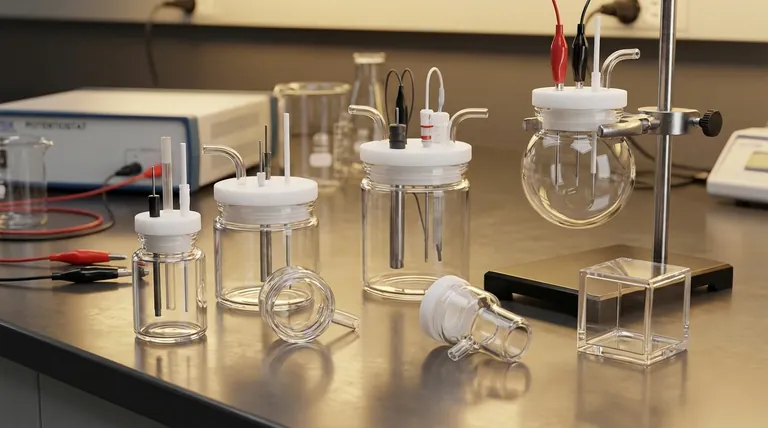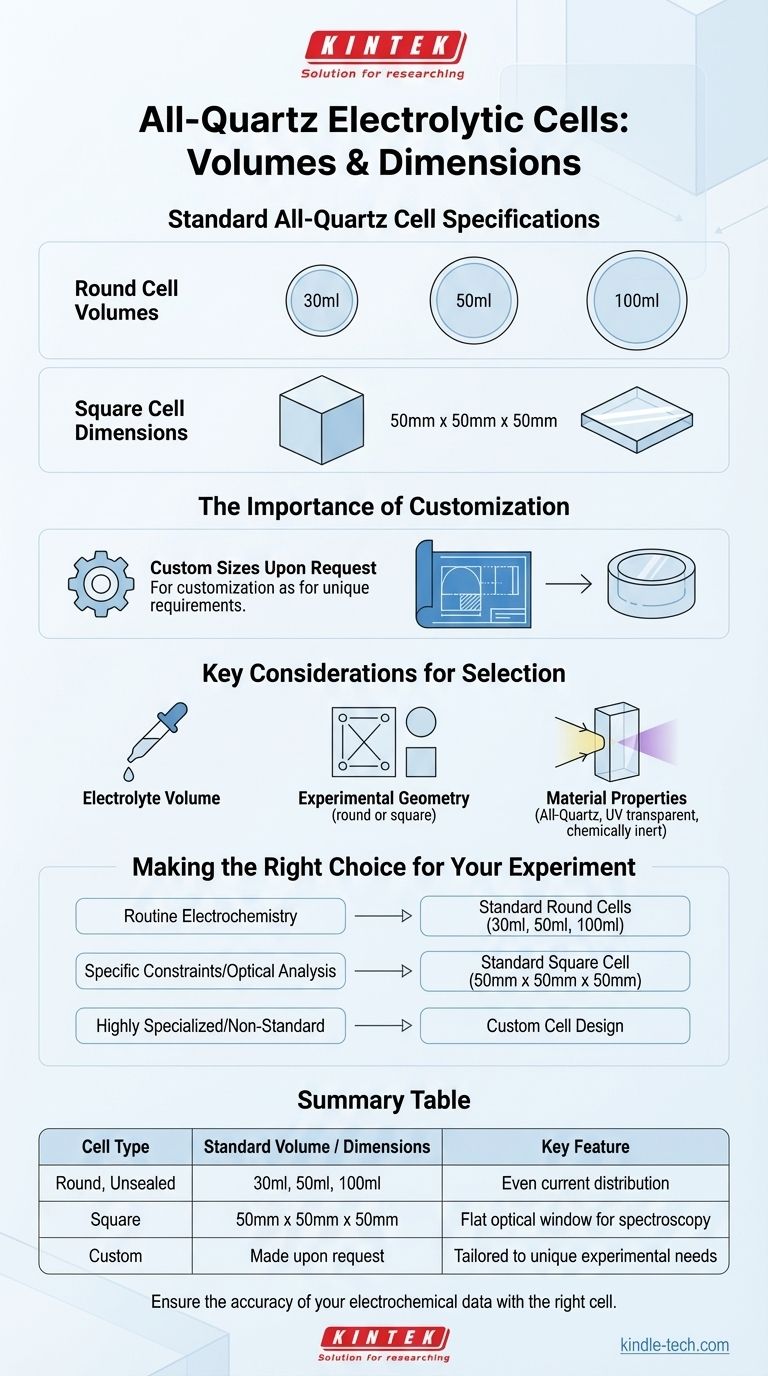For an all-quartz electrolytic cell, standard options include round, unsealed cells in 30ml, 50ml, and 100ml volumes. A standard square quartz cell is also available with dimensions of 50mm x 50mm x 50mm. For experiments with unique requirements, custom sizes can typically be manufactured upon request.
The selection of an electrolytic cell is not just about size, but about matching the cell's volume and geometry to the specific demands of your three-electrode electrochemical system. While standard sizes exist for common applications, customization is a readily available option for specialized research.

Standard All-Quartz Cell Specifications
Understanding the baseline options is the first step in equipping your lab. These standard sizes are designed to accommodate common three-electrode configurations used in electrochemistry.
Round Cell Volumes
The most common configuration is the round, unsealed cell, which promotes even current distribution.
These cells are typically available in three standard volumes:
- 30ml
- 50ml
- 100ml
These options provide flexibility for experiments that vary in electrolyte volume requirements.
Square Cell Dimensions
For experiments that may require a flat optical window for spectroscopic analysis or specific geometric constraints, a square cell is the standard.
The typical offering is a single standard size: 50mm x 50mm x 50mm.
The Importance of Customization
While standard sizes cover many use cases, electrochemical research often involves unique cell designs, electrode geometries, or integration with other analytical equipment.
When to Consider a Custom Cell
Customization becomes necessary when your experimental parameters fall outside standard offerings.
This could be driven by the need for a non-standard volume, a specific path length for optical measurements, or unique ports for electrodes and probes.
The Request Process
As noted in supplier specifications, sizes other than the standard square and round models can be made upon request.
You will typically need to provide detailed drawings or specifications for the required cell to the manufacturer.
Key Considerations for Selection
Choosing the right cell requires balancing several factors related to your specific experimental goals.
Required Electrolyte Volume
The volume of your cell should be appropriate for the amount of analyte available and the size of your electrodes.
Using a cell that is too large can waste precious samples and reagents, while a cell that is too small may not properly accommodate your electrodes.
Experimental Geometry
The choice between a round or square cell often depends on the physical layout of your setup.
Round cells are excellent for general-purpose electrochemistry, whereas square cells are often essential for spectroelectrochemical experiments where a light beam must pass through the cell.
Material Properties
The choice of all-quartz construction is deliberate. Quartz offers high chemical inertness and excellent optical transparency, particularly in the UV spectrum, making it superior to glass for many applications.
Making the Right Choice for Your Experiment
Your decision should be guided directly by your research protocol and equipment.
- If your primary focus is routine electrochemistry: Begin with the standard 30ml, 50ml, or 100ml round cells, as one will likely fit your needs.
- If your setup has specific geometric constraints or requires optical analysis: The standard 50mm x 50mm x 50mm square cell is your starting point.
- If your apparatus is highly specialized or non-standard: You should plan to work with a manufacturer to design a custom cell from the outset.
Selecting the appropriate cell is a foundational step in ensuring the accuracy and reproducibility of your electrochemical data.
Summary Table:
| Cell Type | Standard Volume / Dimensions | Key Feature |
|---|---|---|
| Round, Unsealed | 30ml, 50ml, 100ml | Even current distribution |
| Square | 50mm x 50mm x 50mm | Flat optical window for spectroscopy |
| Custom | Made upon request | Tailored to unique experimental needs |
Ensure the accuracy of your electrochemical data with the right cell.
KINTEK specializes in high-quality lab equipment, including all-quartz electrolytic cells. Whether you need a standard size or a custom design for your unique three-electrode system, our expertise ensures a perfect fit for your research.
Contact our experts today to discuss your specific volume, dimension, and application requirements!
Visual Guide

Related Products
- Quartz Electrolytic Electrochemical Cell for Electrochemical Experiments
- Electrolytic Electrochemical Cell with Five-Port
- H-Type Double-Layer Optical Electrolytic Electrochemical Cell with Water Bath
- Electrolytic Electrochemical Cell for Coating Evaluation
- H Type Electrolytic Cell Triple Electrochemical Cell
People Also Ask
- What are the key features of quartz that make it suitable for electrolytic cells? Discover the 4 Pillars of Superior Performance
- What are the necessary steps to prepare an all-quartz electrolytic cell before an experiment? Ensure Accuracy and Safety
- What are the primary applications of the all-quartz electrolytic cell? Essential for High-Purity & Optical Analysis
- What materials are used to construct the all-quartz electrolytic cell? A Guide to Purity and Performance
- What is the proper procedure for post-experiment cleanup and storage of an all-quartz electrolytic cell? Ensure Longevity and Reproducibility



















